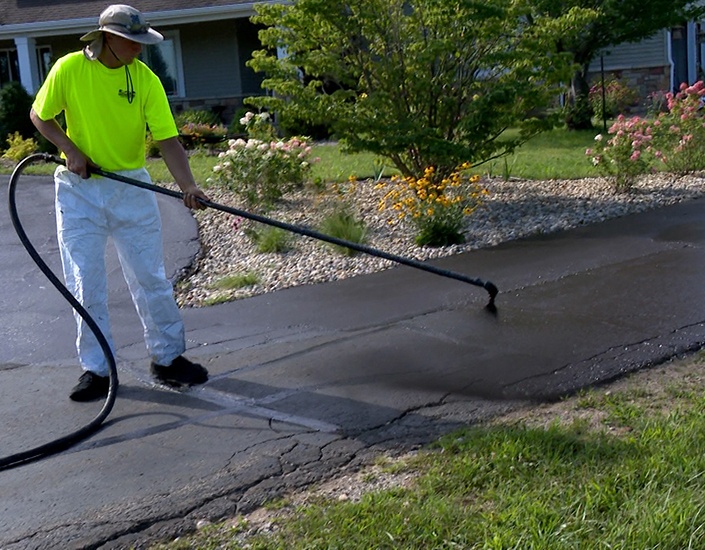Cold Mix Asphalt Vs. Hot Mix Asphalt: Which Is Right for You?

Structure Distinctions
Cold mix asphalt is created by emulsifying the asphalt binder with water and an emulsifying agent prior to blending it with aggregate. The hot mix asphalt production process includes heating up the accumulation and asphalt binder individually before integrating them at the asphalt plant.
Moreover, cold mix asphalt often tends to be less dense and extra versatile than warm mix asphalt. This flexibility makes it much better suited for locations with greater degrees of motion, such as driveways or roads with rush hour. On the other hand, hot mix asphalt is recognized for its high toughness and resistance to rutting and cracking, making it a preferred selection for freeways and high-traffic roads where long life is crucial.
Installation Refine Variances
The process of installing chilly mix and hot mix asphalt displays remarkable differences in their procedures and requirements. Cold mix asphalt, being an extra versatile product, can be used straight from the bag or container onto the fracture or damaged location. It needs very little preparation job, such as cleansing the area and compacting the cold blend with hand tools. This makes it a convenient alternative for short-term and quick repairs. In contrast, hot mix asphalt demands a much more intricate setup procedure. It includes heating up the mix to high temperature levels prior to laying it down on a correctly ready base. The prep work consists of compacting the base, using a tack layer, and making use of hefty equipment like pavers and compactors for a durable and smooth surface. As a result of the home heating needs, warm mix asphalt installments are generally lugged out by specialists with specialized tools, making certain a much more irreversible and structurally audio outcome.
Toughness and Durability Elements
When thinking about asphalt alternatives, toughness and long life are essential variables to review for long lasting pavement performance. Hot mix asphalt (HMA) is understood for its exceptional durability and durability.
In terms of durability, HMA usually outshines CMA as a result of its superior stamina and resistance buildings. HMA pavements have a longer solution life, requiring much less constant repair work and maintenance, which can equate to cost savings in the future. In addition, HMA sidewalks are more quickly adjustable to satisfy particular job demands, better boosting their sturdiness.
Cost Factors To Consider
Considering the economic ramifications is an important element when assessing the selection between hot mix asphalt (HMA) and cool mix asphalt (CMA) for sidewalk projects. While the initial price of hot mix asphalt is typically more than that of chilly mix asphalt, HMA often supplies an extra cost-efficient service over time because of its exceptional resilience and long life. HMA is understood for its capacity to endure heavy web traffic lots and extreme weather, minimizing the demand for regular fixings and maintenance. On the other hand, chilly mix asphalt is extra inexpensive ahead of time yet may need even more frequent patching and resurfacing, leading to greater maintenance costs over time.
In enhancement to material costs, it's necessary to consider the expenses connected with setup and upkeep when contrasting HMA and CMA. HMA normally calls for customized devices and skilled labor for correct installment, which can affect overall task costs. Alternatively, CMA is less complicated to function with and can Read Full Report usually be used utilizing easier i loved this strategies, potentially decreasing installment costs. Eventually, the decision between HMA and CMA must consider not simply the first price yet also the lasting economic effects to identify the most economical alternative for the particular sidewalk project.
Environmental Effect Comparison
Contrast of the ecological impacts in between warm mix asphalt (HMA) and cool mix asphalt (CMA) discloses unique differences in sustainability methods. HMA production requires high temperatures, leading to increased energy usage and greenhouse gas exhausts.
Additionally, using CMA typically involves recycling existing asphalt pavement, advertising resource conservation and decreasing the quantity of waste sent out to landfills. This recycling facet further enhances the sustainability of CMA compared to HMA. On the whole, when taking into consideration the ecological influence, CMA emerges as a much more ecologically sustainable selection because of its reduced energy needs, reduced discharges, and the potential for recycling existing materials. By choosing CMA over HMA, road construction jobs can contribute positively to environmental conservation efforts.
Final Thought
Finally, the choice between cold mix asphalt (CMA) and hot mix asphalt (HMA) depends on various variables such as composition, installment procedure, resilience, durability, cost, and environmental effect. asphalt repair. While CMA supplies a fast and cost-effective service for small fixings, HMA guarantees premium durability and durability for hefty traffic areas. Consider these variables carefully to determine which kind of asphalt is the right selection for your paving needs

Considering the financial implications is a crucial aspect when assessing the choice between warm mix asphalt (HMA) and cool mix asphalt (CMA) for sidewalk projects. While the preliminary expense of hot mix asphalt is asphalt patch repair typically higher than that of cool mix asphalt, HMA usually offers an extra affordable solution in the lengthy run due to its exceptional toughness and longevity. asphalt repair.Contrast of the environmental impacts between hot mix asphalt (HMA) and chilly mix asphalt (CMA) exposes distinctive differences in sustainability methods.In final thought, the selection between chilly mix asphalt (CMA) and hot mix asphalt (HMA) depends on different elements such as make-up, setup process, sturdiness, durability, cost, and ecological impact
Comments on “Effective Asphalt Repair: Cold Mix Sealing Techniques Unveiled”